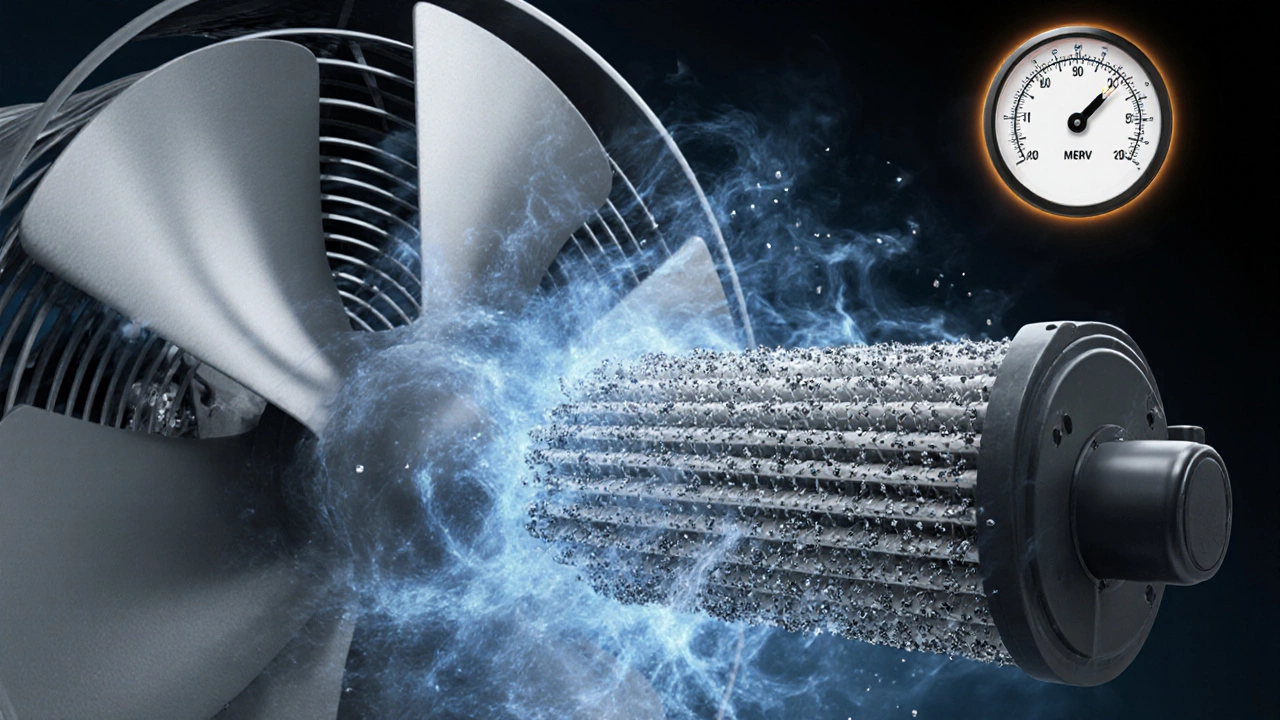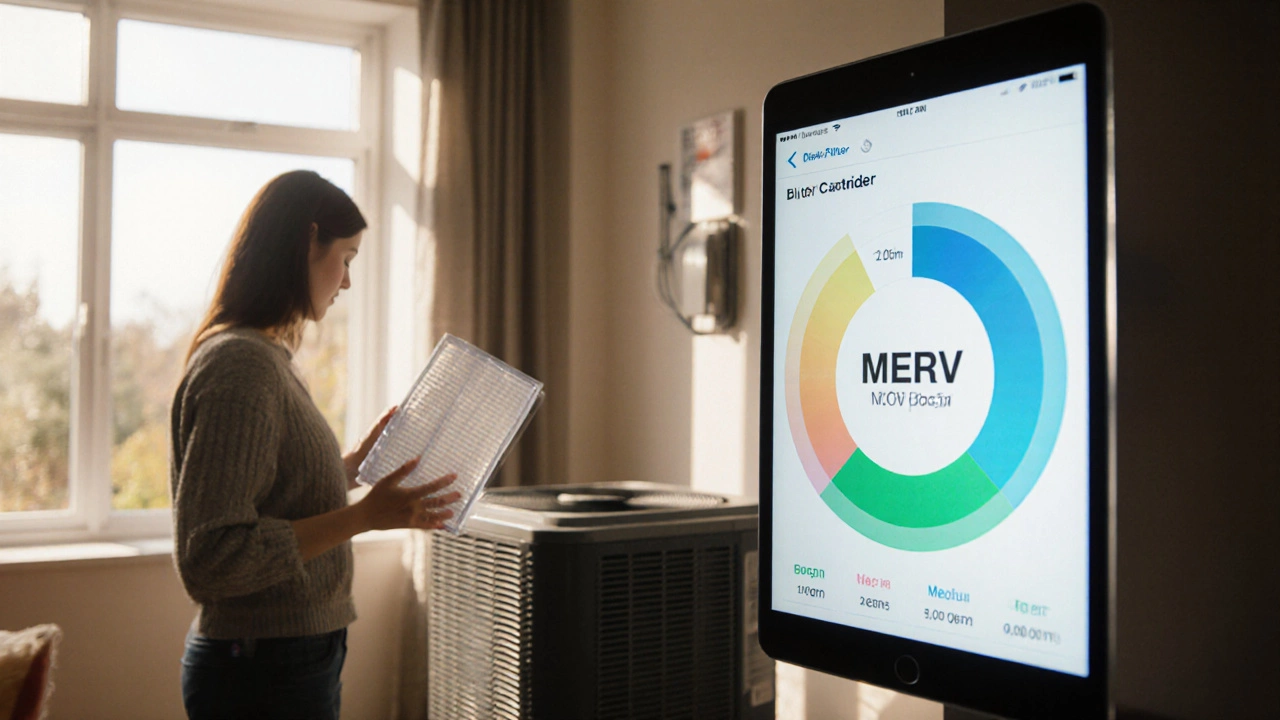MERV Filter Selector
Select Your System Type
Recommended MERV Rating
MERV Comparison Table
| MERV | Particle Size Captured | Static Pressure (inches H₂O) | Recommended Use |
|---|---|---|---|
| 8 | 3 µm - 10 µm (dust, lint) | 0.05 | Standard homes |
| 11 | 1 µm - 3 µm (pollen, mold spores) | 0.10 | Allergy-sensitive households |
| 13 | 0.3 µm - 1 µm (bacteria, smoke) | 0.20 | Medical facilities, high-allergy homes |
| 16 | 0.3 µm - 0.5 µm (viruses, fine particulates) | 0.35 | Clean-room environments, advanced air-purification |
Key Takeaways
- Higher MERV numbers capture smaller particles but restrict airflow.
- Increased static pressure can make your fan work harder and raise energy bills.
- Filters that are too efficient for a system may shorten filter life and cause noise.
- Match the MERV rating to your HVAC capacity and indoor‑air‑quality needs.
- Regular checks and proper installation keep performance in balance.
When you hear "high MERV filters" most people picture crystal‑clear air and fewer allergies. The reality is a bit messier. A filter that grabs 99% of particles the size of a pollen grain can also choke the breath of your heating, ventilation, and air conditioning (HVAC) system, especially if the unit wasn’t designed for that level of resistance.
What a MERV Rating Actually Means
MERV filter is a filter rated by Minimum Efficiency Reporting Value that measures its ability to capture particles of various sizes. The scale runs from 1 (very loose) to 20 (ultra‑high efficiency). A MERV 8 filter typically stops larger dust and lint, while a MERV 13 or higher traps bacteria, smoke, and fine pollen.
The rating is based on laboratory tests that push a known amount of air through the filter and count how many particles of a given size get through. The higher the number, the finer the mesh of fibrous material, and the tighter the seal between the filter’s frame and the housing.
How High MERV Filters Work
Think of a filter as a net. The tighter the weave, the smaller the fish you can catch - but the harder it is for the net to be pulled through water. In HVAC terms, the net’s "tightness" shows up as static pressure. Static pressure is the force the fan must overcome to push air through the filter.
Typical values:
- MERV 8 - 0.05 inchesH₂O (low pressure drop)
- MERV 11 - 0.10 inchesH₂O (moderate)
- MERV 13 - 0.20 inchesH₂O (noticeable)
- MERV 16 - 0.35 inchesH₂O (high)
Those numbers sound tiny, but they add up when air has to travel through ducts, coils, and other components. If the fan can’t keep up, you get reduced airflow, uneven heating or cooling, and higher electricity usage.
Potential Downsides of Going Too High
1. Airflow Restriction and Energy Use
When static pressure climbs, the fan motor draws more current. A 2‑horsepower furnace that normally uses 0.8kW might spike to 1.1kW with a MERV 16 filter. Over a year, that extra load can add 30-50kWh to the bill - not insignificant for a household trying to stay green.
2. Reduced Comfort
Lower airflow means rooms farther from the furnace can feel cooler in winter or hotter in summer. You might notice uneven temperatures, especially in larger homes with long duct runs.
3. Shorter Filter Life
A denser filter captures more particles per pass, so it clogs faster. While a MERV 8 unit might last 12months in a typical home, a MERV 13 could need swapping every 3-4months if you have pets or do a lot of cooking.
4. Compatibility Issues
Not every HVAC system is built to handle high pressure drops. Manufacturers often list a maximum recommended MERV rating - ignoring that can void warranties.
5. Noise Increase
When the fan works harder, it can produce a louder whine. In quiet bedrooms, that extra hum is enough to be annoying.

When High MERV Filters Actually Make Sense
High ratings shine in environments where air quality is critical: hospitals, laboratories, or homes with severe asthma or allergies. In those cases the benefit of trapping fine particles outweighs the modest rise in energy use.
Also, if your home already has a high‑efficiency furnace with a variable‑speed blower, the system can usually absorb the extra pressure without strain.
Choosing the Right MERV for Your Home
Use the quick decision checklist below:
- Check your HVAC manual for the maximum recommended MERV.
- Ask whether your fan is single‑speed (more sensitive) or variable‑speed (more forgiving).
- Consider occupants’ health needs - allergies, asthma, or a newborn may tip the scales toward higher efficiency.
- Evaluate how often you’re willing to change the filter - higher MERV means more frequent swaps.
- Factor in your energy‑cost goals - a higher rating can raise usage by up to 15%.
Installation & Maintenance Tips
- Make sure the filter fits snugly; gaps let unfiltered air bypass the media.
- Install the filter with the airflow arrows pointing toward the furnace.
- Schedule inspections every 3months if you use MERV13 or above.
- Keep return grilles clean - a dirty grille adds extra resistance before the air even reaches the filter.
- If you notice a drop in airflow, measure the static pressure with a manometer or call an HVAC pro.
Comparison of Common MERV Levels
| MERV | Particle Size Captured | Typical Static Pressure (inchesH₂O) | Recommended Use | Average Cost per Filter |
|---|---|---|---|---|
| 8 | 3µm - 10µm (dust, lint) | 0.05 | Standard homes | $5‑$8 |
| 11 | d>1µm - 3µm (pollen, mold spores) | 0.10 | Allergy‑sensitive households | $8‑$12 |
| 13 | 0.3µm - 1µm (bacteria, smoke) | 0.20 | Medical facilities, high‑allergy homes | $12‑$20 |
| 16 | 0.3µm - 0.5µm (viruses, fine particulates) | 0.35 | Clean‑room environments, advanced air‑purification | $20‑$35 |
Frequently Asked Questions
Will a high MERV filter void my furnace warranty?
Most manufacturers specify a maximum MERV rating. Going above that can be considered misuse and may void the warranty. Always check the owner’s manual or contact the maker before upgrading.
How often should I replace a MERV 13 filter?
In a typical single‑family home with pets, replace every 3‑4months. Heavy cooking or dust‑prone areas may need monthly changes.
Can I mix different MERV ratings in the same HVAC system?
Mixing is not recommended because it creates uneven pressure drops across the return side, confusing the airflow balance and potentially shortening the life of the lower‑rated filter.
Do high MERV filters improve energy efficiency?
Usually the opposite. The extra static pressure forces the fan to work harder, which can raise electricity use by 5‑15% depending on the system.
Is a MERV 13 filter suitable for a heat‑pump system?
Most modern heat‑pumps with variable‑speed blowers can handle MERV13 without issue, but you should verify the manufacturer’s rating limit first.

